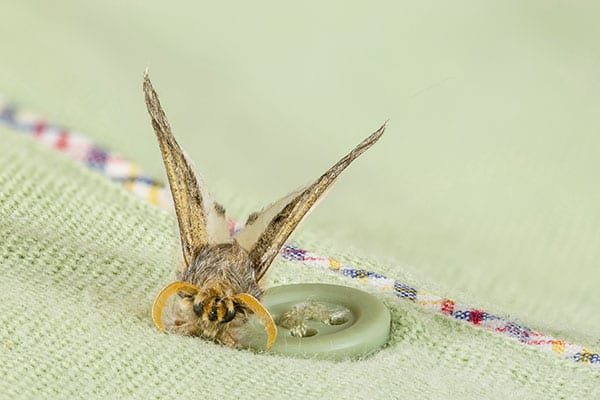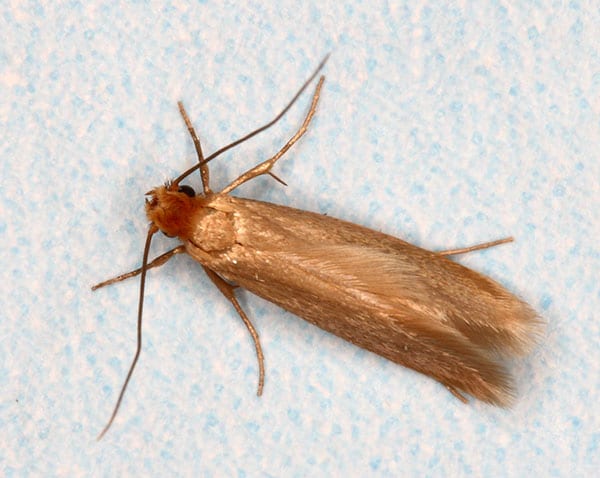Reproductive Behaviour
All species of moths have four stages of development within its life cycle which are the Egg, the Larvae, the Pupae, and the Adult. Their eggs aren’t usually visible as they are shrouded amongst feeding materials (depending on the species) awaiting to hatch. The larvae stages may posses pro-legs and are known as caterpillars which would pupate inside silken cocoons before becoming a month (as would a butterfly). After a number of moults (depending on the species) the larvae would emerge from the silken cocoon a moth becoming sexually mature and repeating the process.
There are number of moths that may be found within a residential or commercial premises for due to feeding and breeding purposes which are listed below:
- Common Clothes Moths (Tineola Bisselliella) The eggs of clothes moths are found amongst clothing, carpet and/or fabric fibres hatching within 5 weeks then becoming caterpillars which can last between 2-7 months being the cycle stage where feeding damage takes place as. They then pupate for a shorter duration before becoming a moth living for up to 10 months which highlights the severity.
- Brown House Moths (Hofmannophila Pseudospretella) The eggs of brown house moths are laid by the 100’s and can be found amongst fur, feathers and are often present in birds nests hatching within 2 weeks – 1 month then becoming caterpillars which can last between 2-5 months being the cycle stage where feeding damage takes place as. They then pupate for a shorter duration before becoming a moth living up to 4 weeks.
- White-Shrouded House Moths (Endrosis Sarcitrella) This moth is commonly associated with stored foodstuffs and food warehouses though may commonly occur in a domestic premises emerging from dry birds nests in eaves or loft spaces. The eggs are laid in the 100’s and hatch in 1-4 weeks becoming caterpillars which can last between 2-5 months being the cycle stage where feeding damage takes place as. They then pupate for a shorter duration before becoming a moth and migrating to another area of premises or away from it.
- Warehouse Moths (Ephestia Elutella) This particular moth thrives in warehouses containing foodstuffs, factories and shops. The eggs of a warehouse moth may be found amongst stacks of stock and are laid in the 100’s over a 2 week duration then becoming caterpillars lasting between 2-4 months which is the cycle stage where feeding damage takes place as. They then pupate for a shorter duration before becoming a moth, becoming sexually mature and mating amongst stacks of foodstuffs leading to contamination of stock and and possibly other premises.
Moths do not cause harm though they are capable of causing severe financial loss to a business or residential property due to the damage of foodstuffs or fabricated materials leaving occupants in distress.


Identifying a Infestation
There are generally two ways of identifying a Moth infestation which is listed below:
Physical Sightings
The easiest way of determining an infestation is of multiple or continuous Sightings of Moths or Larvae as they may be seen individually or clustered together. A thorough check should be carried out by if not yourself, than a specialist if sightings has been made.
Damaged Surroundings
The Larvae of moths cause significant damage as they feed and depending on the species, it may be packets of foodstuffs with holes or fabricated belongings and furnishings with circular patches that you may see along with the target pest in the immediate area.
Identifying a Moth
Identifying moths or their larvae is pretty easy on the circumstance that they make themselves visible. It is their cryptic behaviour and ability of flight that will not make you aware of their presence unless you are fortunate enough to see both moths and larvae or the infestation has become out of control. Below may help you identify an adult Moth of a particular species:
- A Common House Moth is approximately 4 – 7mm in length and their physical appearance is one of a winged, six legged Insect which are small in size with straw coloured fringed wings (held along the body when closed). The Larvae are whitish caterpillars. They may be found clustered together in clothing, carpets and/or fabricated materials within a premises and have also been known to harbour within rooms that generate heat (boiler rooms and carpeted bathrooms).
- A Brown House Moth is approximately 8 – 10mm in length and their physical appearance is one of a winged, six legged Insect which have fringed brownish golden speckled wings (held along the body when closed). The Larvae are whitish caterpillars with brown heads. They can be found where birds may be nesting within a domestic premises working their way throughout dwelling areas and have also been known to harbour within museums.
- White-Shrouded House Moth is approximately 7 – 9mm in length and their physical appearance is one of a winged, six legged Insect which have pale white and gold wings flecked with dark brown with fringed wing bottoms (held along the body when closed). The Larvae are whitish with red/brown heads. They are associated with Food Warehouses and Stored Foodstuffs but can be found in the eaves and loft spaces of a domestic premises.
- Warehouse Moth is approximately 8 -10mm in length and their physical appearance is one of a winged, six legged Insect which have pale buffed wings though wing patterns are variable. The Larvae are whitish with brown heads. They can be found in commercial environments such as warehouses, food factories and shops.
